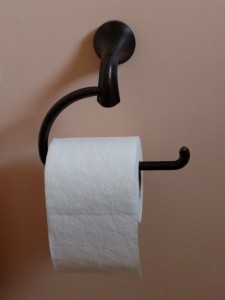When potty training gets hard: constipation

 Unfortunately, constipation and potty training go together.
Unfortunately, constipation and potty training go together.
This should come as no surprise. Let’s consider the two favorite words of two and three-year-olds:
“Mine,” and “No.”
Now think of how these words apply to a toddler who is starting to understand the purpose of the potty. The well meaning parent says, “Honey, we want you to put your poop to the potty.”
For many toddlers, the answer is… “NO! MINE!”
The problem begins when the toddler is determined NOT to give up her own poop. The longer your child holds in the poop, the harder and more difficult it will be to pass the poop. Thus, a vicious cycle begins. Your child finds pooping painful and scary. This cycle must be interrupted. Here are some tips:
Stop potty training and go back to diapers.
Before you groan at this suggestion, hear this story: The parents of one 2 ½-year-old were pleased that all “pee pee” was making it into the potty, but dismayed that she demanded a Pull-Up for poop. I suggested that she should wear diapers full time, and when pee AND poop go in the potty, then the princess underwear would come back. The child responded to me, “That isn’t very nice!” But guess what? That night, she pooped in the potty. Of course, her baby sibling is due in a few weeks, so we’ll see if success continues… but regression with new babies is a topic for another blog post.
Make the poop easy to pass.
Use natural interventions: increase water throughout the day and give undiluted juice such as prune, pear, apple, or pineapple (the other juices don’t hurt but do not actually help the cause) once a day. Offer fresh fruits, fresh vegetables, and high fiber cereals (just read the labels, try for more than 3 grams per serving). Encourage exercise.
Practice regular potty/toilet sitting.
Catch the poop when it’s naturally likely to come. The most likely time a toddler will poop is just after eating because of the gastrocolic reflex, a reflex which causes the bowels to move after eating. After every meal, have your potty trainer sit for 2-5 minutes. Treat this as a house rule. Read a book on the potty or tell stories to help pass the time.
Teach your child to prioritize pooping over playing.
If kids “really have to go” but they are busy playing, they will hold in the poop to avoid interruption. Watch for signs of a need to defecate such as squirming (better known as the potty dance) or hiding. To avoid a power struggle, say something like, “The poop wants to come out, let’s go,” rather than, “Do you want to go to the potty now?” and reward the child for sitting, not for producing.
Some over-the-counter products can help. You should discuss dosing, timing, risks, and benefits of each with your child’s health care provider before choosing. Medicines include:
- Mineral oil: mix with something that tastes good such as juice or chocolate milk. The brand Kondremul tastes sweet and is hidden easily in milk because it’s white. Mineral Oil makes poop so slippery that even a determined toddler will not “hold it.”
- Polyethyleneglycol (PEG) 3350 (Miralax): with a prescribed amount of liquid, it has no taste and pulls extra water into the bowels so that the poop stays soft.
- Glycerin suppositories: can be the “quick fix” step before you have to resort to enemas, which are more traumatic.
- Children’s laxatives such as Milk of Magnesia.
- Senna-containing products – in the past there were concerns of bowel dependency with long-term use. This concern has been questioned by specialists. Ask your doctor about the products.
At one potty training child’s three year birthday party, the poor birthday boy spent half his party trying to pass a large hard poop, the result of several days of withholding. After one small glycerin suppository and a large amount of anxiety, he rejoined his friends; leaving his parents feeling guilty that they had not paid attention to his pooping frequency prior to the party. While the goal is for our children to be completely independent potty users, we have to help our potty trainers by keeping track of the frequency and consistency of their poop in order to prevent a withholding/painful pooping/constipation cycle from starting.
Be alert to potential medical causes of constipation (as opposed to behavioral or situational) and consult your child’s health care provider if you can’t seem to remedy the problem.
In the world of young potty trainers, try to avoid power struggles, “keep things moving,” make things soft and easy, and remember that this too shall pass.
Julie Kardos, MD with Naline Lai, MD
© 2010 Two Peds in a Pod®
updated 2017